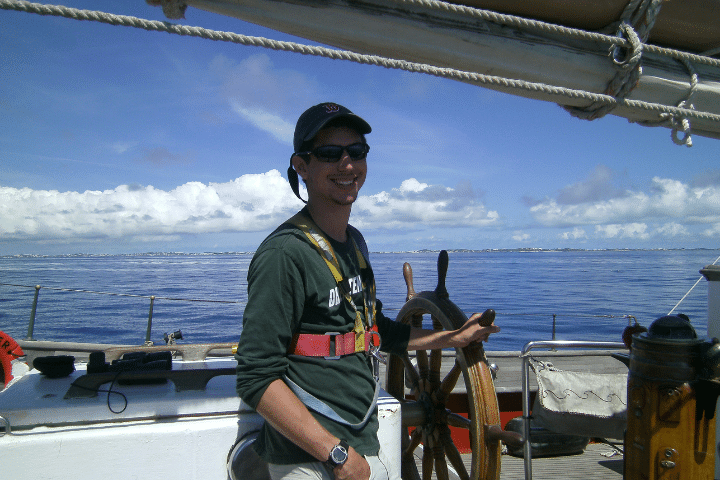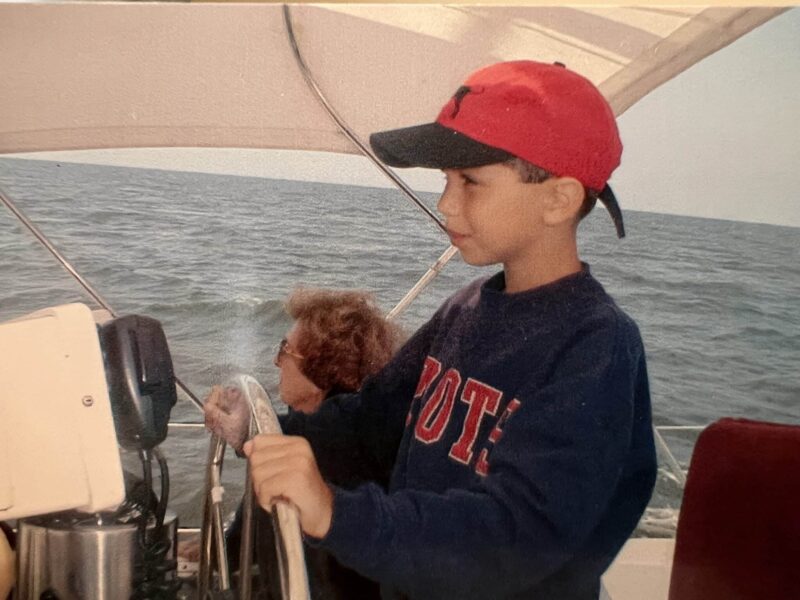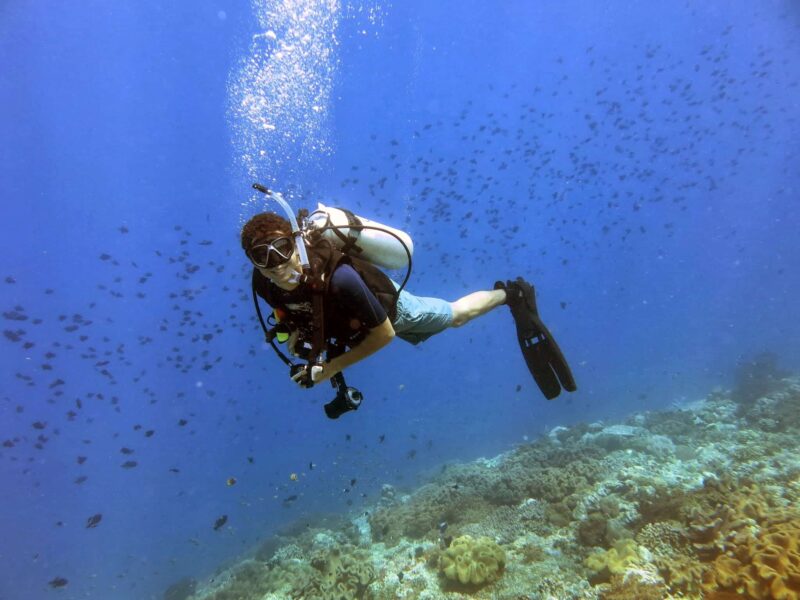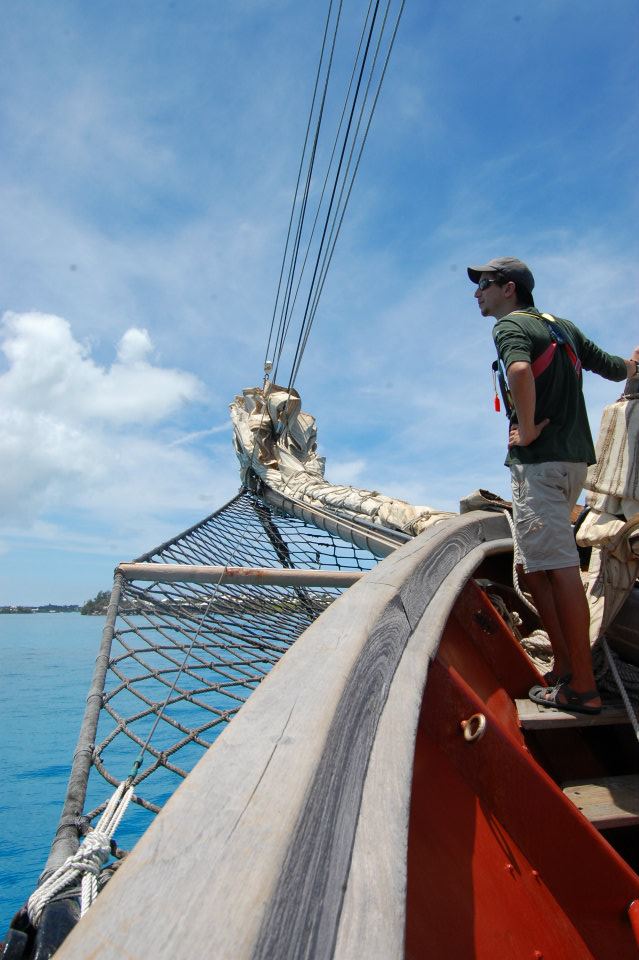
Meet Jeremy Pivor, Bow Seat’s New Partnership & Youth Engagement Director!
September 22, 2023It was 3:00 am when I sluggishly climbed the ladder onto the deck of the S.V. Corwith Cramer, a 134-foot tall ship that myself, 16 other students, and 13 crew members had been living on for the past month in the Sargasso Sea. Waves crashed around the ship, glowing fluorescent green as the nutrient-rich bioluminescence of the Gulf Stream created a spectacle. My mate instructed me to take the helm and head North. I looked up at the cloudless night sky, a planetarium of constellations, and found the North Star. I lined up the mast of the ship with the star and sailed North.
Hello Bow Seat community! My name is Jeremy and I share the above excerpt with you because it was the moment in my life when I felt the most present and at peace. The ocean has always had that effect on me ever since I was a child roaming the beaches of Cape Cod and sailing with my grandparents.

Sailing my grandparent’s boat
When I entered high school, I wanted to learn more about the ocean and the life it supports, so I volunteered in the education department of the New England Aquarium. I spent every Saturday talking to people about coral reefs, carrying around the jaws of great white sharks, conducting presentations with animals like baby anacondas, and even dancing outside in a turtle costume. My time at the Aquarium not only strengthened my passion for the ocean, but also taught me how all life is linked to the sea.

Dance-off at the Aquarium
I went to college in the heart of the United States with no ocean in sight, surprising both myself and my family, but wanting to gain a diversity of experiences. It wasn’t long though (after a summer trapping ticks and mosquitoes), that I went back to the water. Throughout the rest of my university experience, I studied Environmental Biology, spending my time researching how oyster reefs filtrate water to protect human health; examining how community conservation in Madagascar can improve coral reef biodiversity and fish stocks; and sailing aboard a tall ship investigating the population of Caribbean Spiny Lobsters throughout the Sargasso Sea. The human-environment linkages fascinated me, but I didn’t want to just conduct research, I wanted to work with people.
I was lucky to receive a fellowship after college to live in Indonesia and work with an ocean conservation nonprofit, the Coral Triangle Center (CTC). The Coral Triangle is in Southeast Asia and the West Pacific, and is home to the most biodiverse coral reef and fish populations. Most of the people who live there depend on the health of the ocean. With the CTC, we worked collaboratively with communities across Indonesia to develop marine protected areas (MPAs), which help ensure that human priorities are met while safeguarding conservation of critically important marine places and resources.

Diving the reefs of the Banda Islands, Indonesia
During one of my trips to visit a Bajo community, Indonesian nomadic seafolk, I saw firsthand the complicated factors of poverty and health driving environmental degradation. I talked with fishermen, and they told me they use destructive practices like bomb or poison fishing because they need to pay for their child’s healthcare or put food on the table. Climate change has further exacerbated these issues by damaging coral reefs and pushing fishermen farther out to sea to catch what they need to support their family. Seeing this firsthand was a revelation for me. I don’t blame these fishermen because I would do anything to protect my children, too. This was when I first started learning about Planetary Health.
Planetary Health is a field and social movement focused on the links between global environmental change and human health. It is an area I’m incredibly passionate about not only because of my ocean conservation background, but also because of my history living with cancer since I was twelve years old. Outside of my environmental work, I am dedicated to cancer advocacy, and view health justice as intertwined with environmental justice.
With this Planetary Health framing, I was hired by Health in Harmony to conduct a community and environment survey at their sister organization site, Alam Sehat Lestari (ASRI), in Kalimantan (another island of Indonesia). ASRI is both a hospital and forest conservation organization providing services to communities surrounding a critically important national park for endangered Orangutans. Loggers in the area voiced that to stop logging, they needed affordable access to healthcare and training in organic farming, so ASRI started providing both and much more. While I wasn’t focused on the ocean during this time, it was exciting to help both people and the environment simultaneously.

Heading up river to an Orangutan research facility
I took all these experiences and joined a joint medical and master’s degree program in California. While the medical degree ended up not being for me, I received my master’s from U.C. Berkeley School of Public Health, and subsequently joined the Planetary Health Alliance (PHA) at Harvard. The PHA is a global consortium of organizations and individuals leading the field and movement of Planetary Health. Bow Seat president, Linda Cabot, is a board member at the PHA!
While at the PHA, I focused on creating coalitions and partnerships to build the Planetary Health community. I organized the first global declaration on Planetary Health called the São Paulo Declaration, which outlines actions different stakeholders can take. I also worked to develop Regional Hubs from Latin America, Europe, to Oceania. I loved my 3+ years with the PHA and the friendships I made, but I am incredibly excited to now join Bow Seat as Partnership & Youth Engagement Director.
I cannot wait to learn from the current Bow Seat team, Future Blue Youth Council members, and the entire community. I then hope to collaboratively strive to build upon the great work already achieved with the “for youth – by youth” Fellowship Grant Program, develop creative partnerships, and incorporate Planetary Health into Bow Seat activities.
When I lived on the tall ship in college, my favorite place to be was the bow seat. It wasn’t because that was where the dolphins would congregate (although that was pretty cool!), but because as I stared forward with nothing but ocean between me and the horizon, I got a feeling of endless possibilities.
All the young people who are part of Bow Seat give me that same feeling, and I cannot wait to sail our ship towards new adventures.
Onwards
-Jeremy

